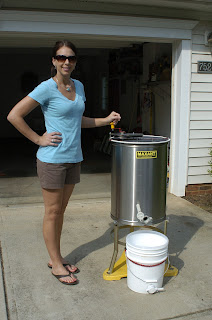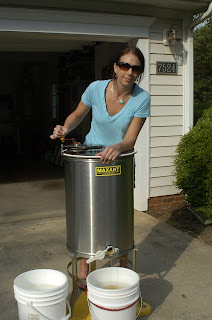I checked on the #4 hive today to see if any of the young nurse bees have started to make a new Queen bee. There was only 1 capped queen cell (on frame 3) and 1 queen cup (on frame 5) with a larvae swimming in royal jelly.
According to the calendar, the queen in the capped cell should hatch on Wednesday, June 6. By this date, the second queen in development will have been capped and the new queen that hatched first will kill it. There can only be one queen per hive.
The other 3 hives looked good and it seems like the nectar flow is over for now as they are eating their honey stores.
The Old North State Honey adventure began in December 2010 when we signed up for "Bee School" in Charlotte, NC.
We learned a ton of valuable information, and in in late spring 2011 we purchased 2 new empty hives, all the supplies and tools that go along with it and 2 nucs of honey bees.
This Blog is intended to capture our activities as we embark on our 1st full year of beekeeping and hopefully harvesting some sweet, all natural, local honey!!!
Thursday, May 31, 2012
Sunday, May 27, 2012
Splitting Hive 1 To Make The Hive 4 - (May 25)
Today I split Hive 1 (Chris's hive). These bees are hard workers, did not try to swarm in the spring and the queen is a really good layer. They also produced a good amount of honey in short amount of time in 2012. This is the Buckfast queen I purchased in 2011. I want to carry on these characteristics so will split the hive.
I found 5 frames of young eggs, 3 frames of food / pollen / capped brood and 2 frames of capped honey. I removed all bees from these frames and put the frames in the 4th hive body and put empty frames in the #1 hive. I placed a queen excluder on top of the #1 hive and the #4 hive on top of the queen excluder. The idea is that all of the nurse bees will return to the frames they were originally on within an hour or so. This also ensures the Queen bee will stay in hive #1.
After an hour and a half I removed the Hive 4 (now full of nurse bees) and put it on the other hive stand with a bucket feeder and closed everything up.
The nurse bees will quickly figure out they are now queenless and will start to make a new queen, hence carrying on the genes to the new colony. If things go well, I look for a new Buckfast queen to emerge in 12 days. This will be around June 6, 2012. From there she will go on a mating flight in 18 days and will hopefully be laying in 28 days. This will be around June 11-12, 2012. She should be laying around June 24, 2012.
FINGERS CROSSED!!! If this works, we will have hive #4 which I will heavily feed the rest of the year to prepare them for winter.
Here is the Queen calendar based on when I made this split:
I found 5 frames of young eggs, 3 frames of food / pollen / capped brood and 2 frames of capped honey. I removed all bees from these frames and put the frames in the 4th hive body and put empty frames in the #1 hive. I placed a queen excluder on top of the #1 hive and the #4 hive on top of the queen excluder. The idea is that all of the nurse bees will return to the frames they were originally on within an hour or so. This also ensures the Queen bee will stay in hive #1.
After an hour and a half I removed the Hive 4 (now full of nurse bees) and put it on the other hive stand with a bucket feeder and closed everything up.
The nurse bees will quickly figure out they are now queenless and will start to make a new queen, hence carrying on the genes to the new colony. If things go well, I look for a new Buckfast queen to emerge in 12 days. This will be around June 6, 2012. From there she will go on a mating flight in 18 days and will hopefully be laying in 28 days. This will be around June 11-12, 2012. She should be laying around June 24, 2012.
FINGERS CROSSED!!! If this works, we will have hive #4 which I will heavily feed the rest of the year to prepare them for winter.
Here is the Queen calendar based on when I made this split:
Day #
|
DOW
|
Date
|
Task/Status
|
1
|
Tuesday
|
22-May
|
The egg is laid by the queen mother.
|
2
|
Wednesday
|
23-May
| |
3
|
Thursday
|
24-May
| |
4
|
Friday
|
25-May
|
Insert into a queenless cell builder colony.
|
5
|
Saturday
|
26-May
| |
6
|
Sunday
|
27-May
|
Check your Hive. The bees should have started to to draw out the cells and feed the larvae with royal jelly. If not, re-graft.
|
7
|
Monday
|
28-May
| |
8
|
Tuesday
|
29-May
| |
9
|
Wednesday
|
30-May
|
Queen cells are capped
|
10
|
Thursday
|
31-May
|
Sensitive developmental phase - do not move cells and be very gentle when opening the hive.
|
11
|
Friday
|
1-Jun
| |
12
|
Saturday
|
2-Jun
| |
13
|
Sunday
|
3-Jun
| |
14
|
Monday
|
4-Jun
| |
15
|
Tuesday
|
5-Jun
| |
16
|
Wednesday
|
6-Jun
|
Queens hatch
|
17
|
Thursday
|
7-Jun
| |
18
|
Friday
|
8-Jun
|
Discard any unhatched cells
|
19
|
Saturday
|
9-Jun
| |
20
|
Sunday
|
10-Jun
| |
21
|
Monday
|
11-Jun
|
Mating Flights
|
22
|
Tuesday
|
12-Jun
| |
23
|
Wednesday
|
13-Jun
| |
24
|
Thursday
|
14-Jun
| |
25
|
Friday
|
15-Jun
| |
26
|
Saturday
|
16-Jun
| |
27
|
Sunday
|
17-Jun
| |
28
|
Monday
|
18-Jun
| |
29
|
Tuesday
|
19-Jun
| |
30
|
Wednesday
|
20-Jun
| |
31
|
Thursday
|
21-Jun
| |
32
|
Friday
|
22-Jun
| |
33
|
Saturday
|
23-Jun
| |
34
|
Sunday
|
24-Jun
|
Check Hive for eggs.
|
35
|
Monday
|
25-Jun
| |
36
|
Tuesday
|
26-Jun
| |
37
|
Wednesday
|
27-Jun
| |
38
|
Thursday
|
28-Jun
| |
39
|
Friday
|
29-Jun
|
Check Hive for larvae.
|
40
|
Saturday
|
30-Jun
|
Larvae found? If so, the queen is ready!
|
41
|
Sunday
|
1-Jul
|
Re-queen if no eggs are present.
|
Thursday, May 24, 2012
Honey Extraction - (May 18)
We have 2 Medium supers (9 frames per super) and an additional 5 medium frames from a 3rd super that we extracted today. We got a total of 89 pounds of honey from 23 medium frames. That's approx. 4 pounds of honey per frame.
We were only able to extract from my hive as Christin's hive is still not as populated and working in numbers as we would like since it got off to a late start due to the queen issues we faced in early spring.
Here are some pictures from the extraction process.
We were only able to extract from my hive as Christin's hive is still not as populated and working in numbers as we would like since it got off to a late start due to the queen issues we faced in early spring.
Here are some pictures from the extraction process.
The 2 Medium supers full of capped honey!! The weight of the top super was 56 pounds and the bottom super weighed 60 pounds.
The 9 frame extractor with a 400 micron strainer over the 5 gallon bucket. We strained the honey to catch any bits of wax We will only extract 6 frames at a time.
We used a heat gun to uncap (melt) the white wax that covers the honey. As I work my way down the frame, you can see the honey is now exposed from the heat melting the thin layer of wax. The typical method is to use a knife to cut the caps off causing a huge mess and about 5%-10% loss of honey. There was no mess using this method.
6 frames placed in the extractor ready to spin for at least 8 minutes. The honey will be forced out of the comb, hit the wall of the extractor and fall to the bottom where it pours out.
Christin spinning the frames. We spun them for about 8 minutes and then reversed the rotation for a few more minutes.
Pure honey pouring out of the extractor.
An empty frame after extracting.
The comb from one frame fell apart during the extraction so we got to enjoy chewing on some comb.
The finished product!!!
Subscribe to:
Comments (Atom)








